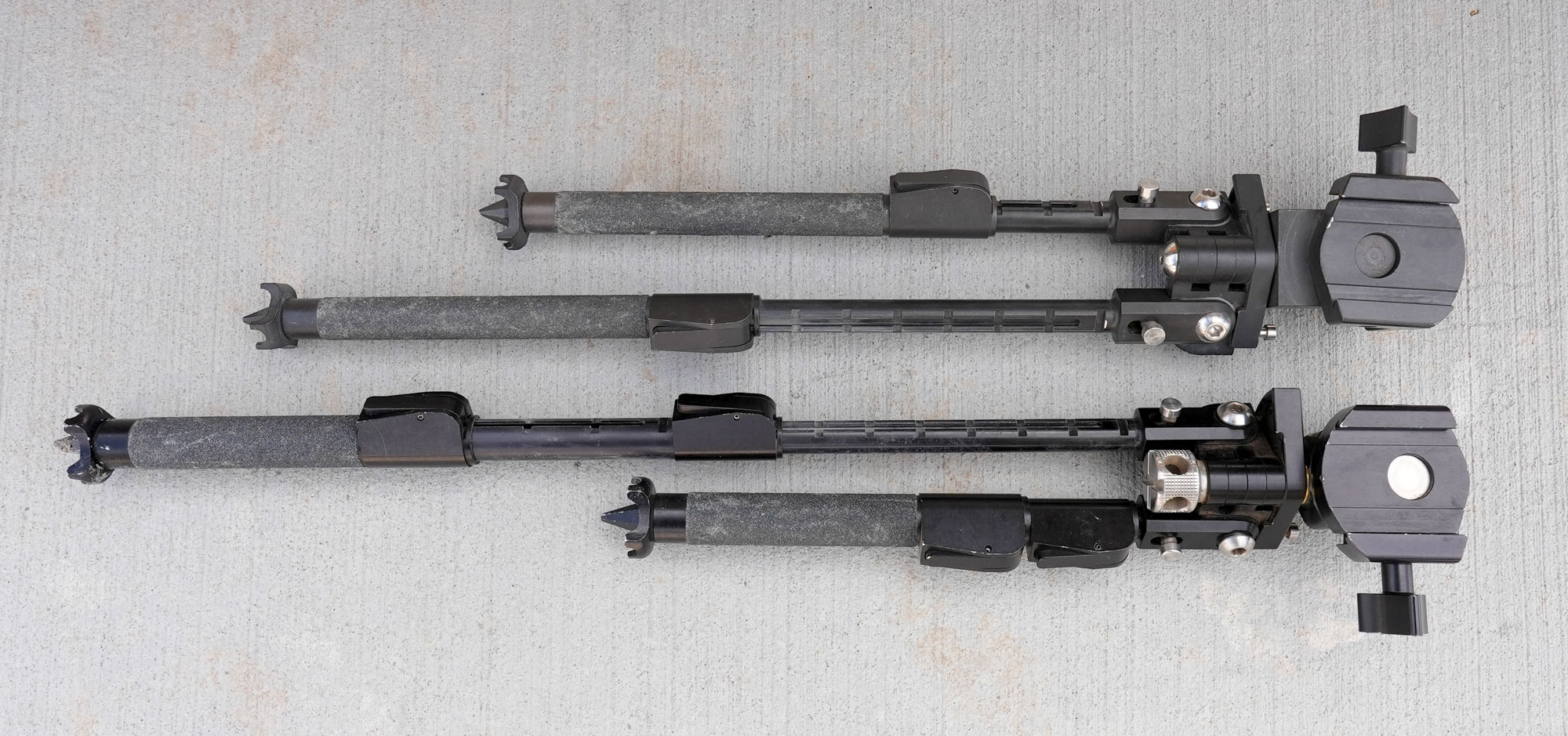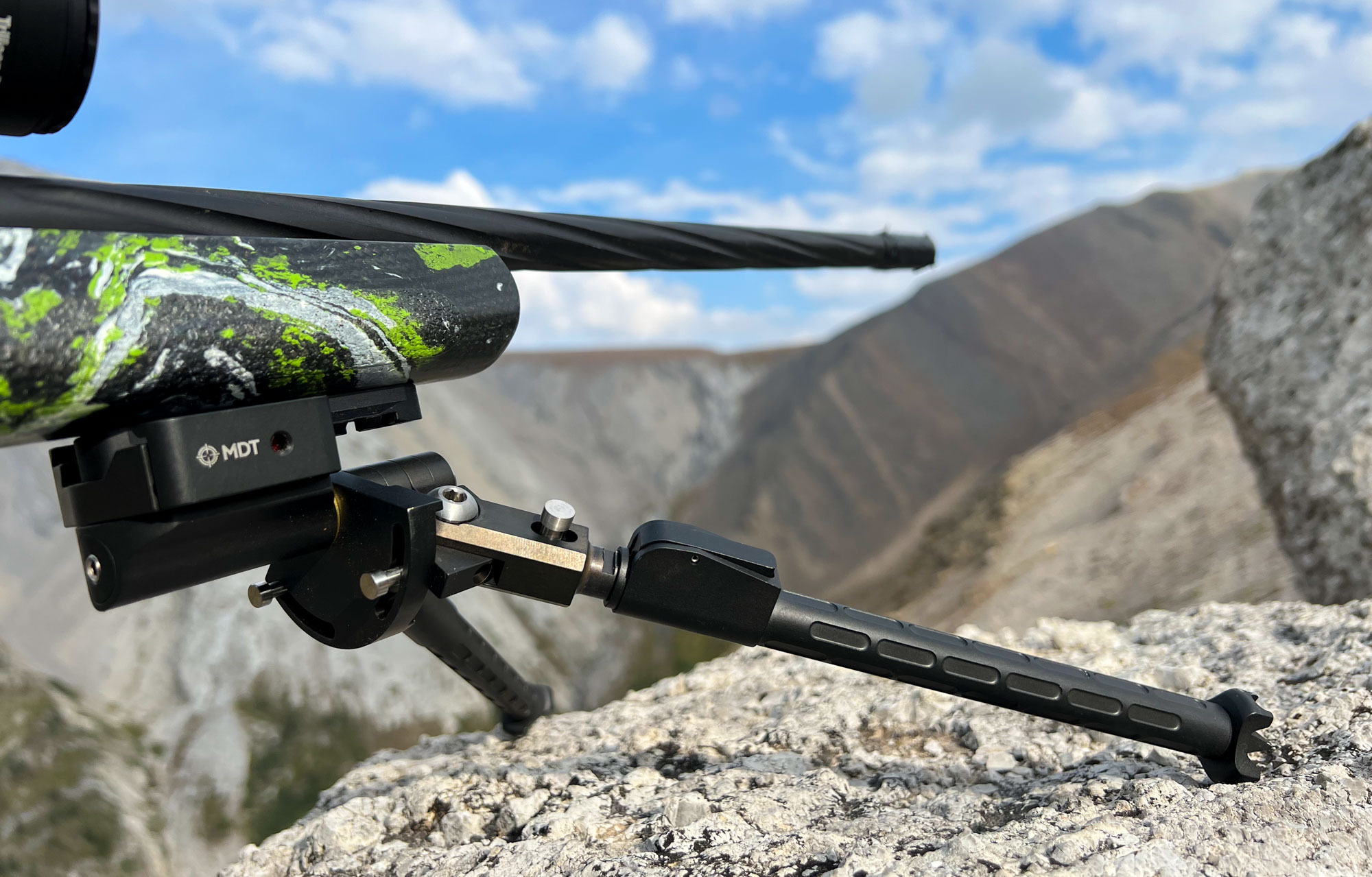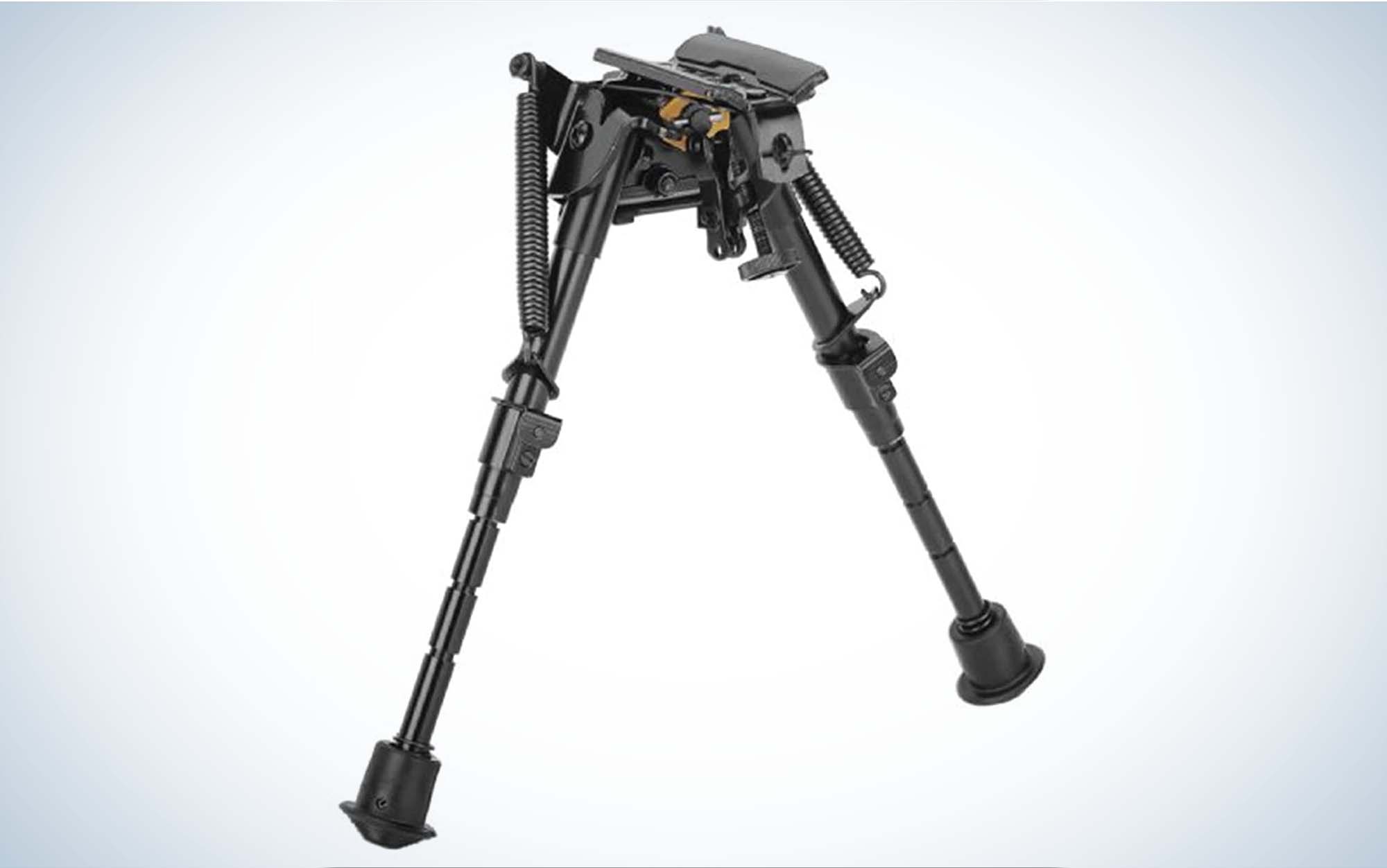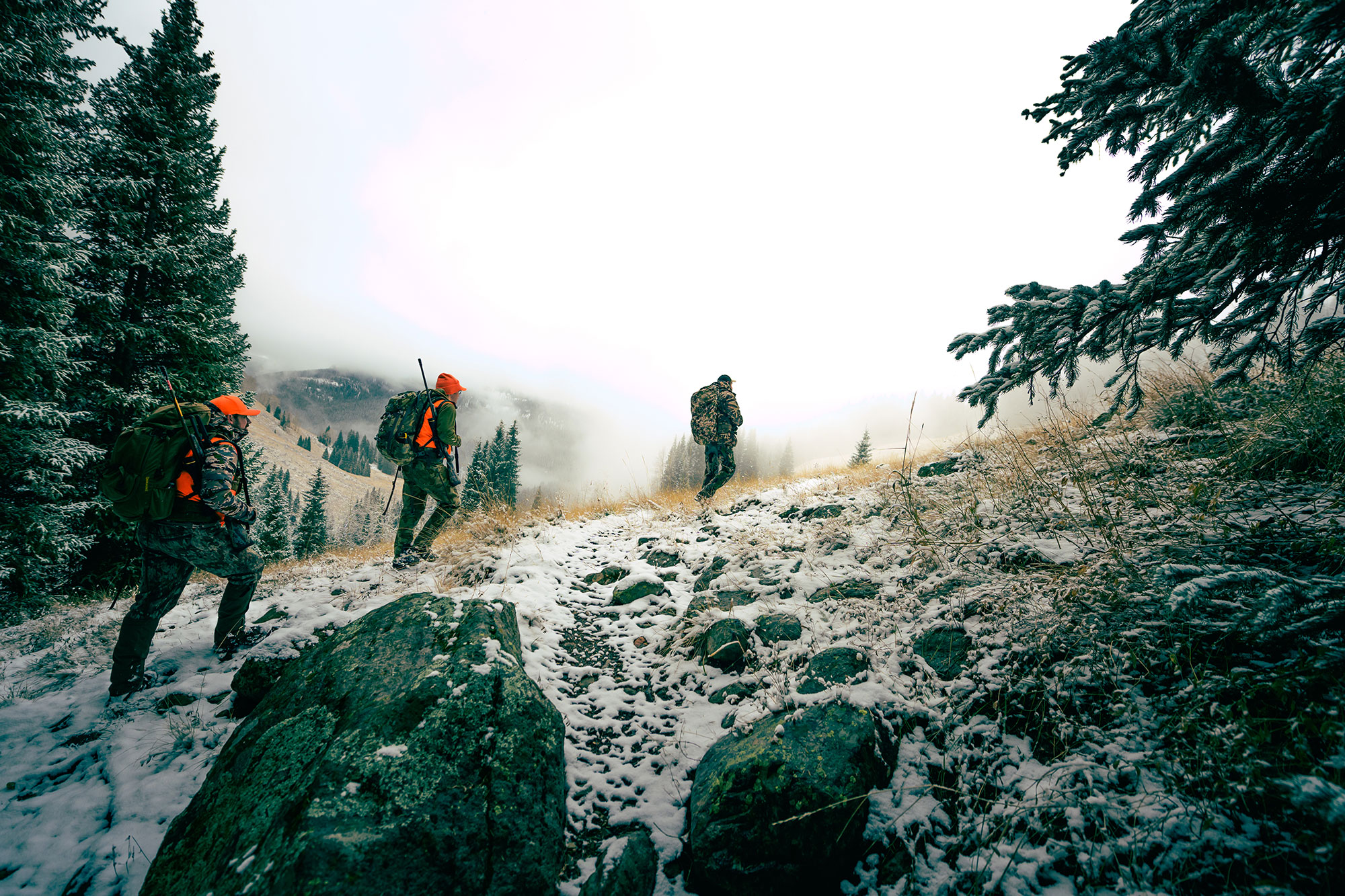We may earn revenue from the products available on this page and participate in affiliate programs. Learn More ›
The best bipod to use depends on your specific needs and the configuration of your rifle. It wasn’t always so complicated. Years back when all rifles had swivel studs as attachment points and there were only a couple bipod makers worth paying attention to, the answer was simple. Go with a Harris. Depending on your situation, that’s still not a bad choice.
But we’ve witnessed an explosion in the variety of bipods in recent years driven by niche applications that make the question of what the best rifle bipod is a bit tougher to answer. This is a good problem, however. Whether you’re looking for a rifle bipod for mountain hunting, precision rifle competition, extreme long-range shooting, or something that will fit a modest budget—there are myriad offerings to choose from. What we’ve listed here are the best bipods of the lot.
- Best Entry-Level: Harris S
- Best Budget: Magpul MOE
- Best Budget Runner-Up: Caldwell XLA Pivot
- Best General Precision Rifle Bipod: Atlas BT10 V8
- Best Precision Rifle Bipod: MDT Ckye-Pod Gen2
- Best Lightweight: Spartan Javelin Lite Rifle Bipod
- Best for NRL Hunter: MDT Ckye-Pod Lightweight Single Pull
Putting The Best Bipods To The Test

The bipods listed here are ones that I and my fellow Outdoor Life editors have used and vetted. They are the ones we take into the mountains, use during gun tests for evaluating rifle accuracy off a bench, and are part of our kit for long-range matches.
The conclusions here are based on years of shooting and hunting experience with the various models and shooting them head-to-head against each other and others in their niche.
Best Bipods: Reviews & Recommendations
Best Entry-Level: Harris S
Pros
- Classic, bomb-proof design
- Easy to operate
- Affordable
- Lots of add-ons in Harris ecosystem available
Cons
- Not a lot of adjustability in system

So many cliches can describe Harris bipods. Rock solid. Time tested. Tried and true. They all apply. As an all-around quality bipod that is reasonably priced, the Harris S-series remains a top choice.
The legs on this model extend from 9 to 13 inches when the tab holding the spring-loaded legs is depressed. A wheel on the rear of the bipod controls the tension on the tilt feature. With heavy rifles it can be difficult to keep it tight enough to prevent the rifle from wanting to flop over. If you encounter that, consider getting a replacement wheel with a handle on it that can be cranked down tighter.

The legs only have two positions—stowed or 90 degrees down, and the width of the feet is fixed as well. That said, there are a ton of aftermarket accessories to configure Harris bipods to your liking.
When I’m using a rifle with a single swivel stud up front, the Harris S-series is what I most often turn to.
Best Budget: Magpul MOE
Pros
- Simple
- Affordable
- Lightweight
Cons
- Not a lot of adjustability in system
- Bulky profile looks out of place on slender rifles
The polymer Magpul MOE is a stripped-down, basic, affordable, and effective bipod. What you see is what you get with the MOE. The two legs deploy easily by hand and lock into position. Push buttons on either leg lets you extend them from about 7 to 10 inches in ½-inch steps.

The bipod has rubber feet that grip well but can be replaced with common aftermarket feet if you want something different.
The bipod locks onto a swivel stud via a large thumb wheel that is easy to manipulate and tighten. In the stowed position the bipod doesn’t extend very far beneath the fore-end, which is nice. The bipod only weighs 8 ounces, though the silhouette of the Magpul MOE is pretty chunky. While it looks right at home on ARs and modern chassis rifles, it can be an odd match with a more traditionally configured deer gun.
Best Budget Runner Up: Caldwell XLA Pivot
Pros
- Inexpensive
- Proven design
Cons
- Limited versatility
- Not as durable as premium bipods

At around 50 bucks, the Caldwell XLA Pivot—which borrows heavily from the original Harris bipod design—is tough to beat. It comes with four different leg configurations: 6 to 9 inches; 9 to 13 inches; 13 to 23 inches; and 13.5 to 27 inches.
It uses a single thumb wheel to clamp onto a swivel stud and has legs that use stout external springs to hold them rigidly in position, whether deployed or stowed.
The legs have index grooves on them to set their height and are tipped with rubber feet. Likewise, the cradle that contacts the fore-end has a rubber lining to prevent marring the stock. The cradle cants a total of 18-degrees to help the shooter level the rifle on uneven terrain.
I’ve used these bipods many times in the past and they are solid performers. There’s nothing fancy about them, but there’s nothing wrong either.
Best General Precision Rifle Bipod: Atlas BT10 V8
Pros
- Easy to deploy
- Versatile
- Durable
Cons
- Slightly expensive

I’ve been running Atlas bipods for a long time. I’ve got at least a half-dozen in my inventory in various configurations. For general precision rifle work—whether on a bolt gun or semi-auto AR-type gas rig—they are the best rifle bipod in light of the balance they strike with providing solid support, their ease of use, versatility, durability, and price.
They are nicely machined out of aluminum and aren’t excessively bulky. The legs can be placed in five different positions from 0 to 180 degrees. The legs on this model go from 6.5 to 10 inches in length. That degree of adjustability makes them very adaptable to different types of terrain. The feet can also be swapped from the standard rubber pads to spiked versions.
The spring-loaded collars on the legs, which are used to set the leg length, are relatively easy to manipulate while you’re set up behind the gun, meaning you can make adjustments quickly. This can be a lifesaver whether you’re in the middle of a stage during a match or about to shoot a deer of a lifetime.
Atlas bipods are stiff for their size and can take being loaded hard. The heads they’re built on traverse 30-degrees for panning and they have a bit of cant on tap as well to easily level your rifle. This version weighs about 13 ounces.
Atlas bipods have three attachment options: Quick detach Picatinny (my favorite, though it adds about $60 to the price), permanently secured with two screws to a Picatinny rail, or a modular clamping option for use with other systems (ARMS 17S, Badger Ordnance Tramp, LaRue Tactical LT271, etc.).
Best Precision Rifle Bipod: MDT Ckye-Pod Gen2
Pros
- Excellent versatility and speed
- Great stability
Cons
- Expensive
- Heavy

A lot of the top competitors in practical precision rifle disciplines like PRS, NRL, RTC and others run—or aspire to run—MDT Ckye Pods. The versatility, speed, and support offered by these bipods is second-to-none. They are arguably the best rifle bipod being made today.
MDT purchased the design from my buddy Ckye Thomas a few years back and moved production to their facilities in Canada. After some growing pains, they worked the kinks out of mass producing this complex design and have rolled out a number of models.
The Gen2 models come in a few configurations. The single-pull leg design is still the most common. The legs adjust from 9.5 to 14.5 inches in length. The leg width is adjustable too—from pinched close together to get the gun up high, to spread ridiculously far apart to keep the rifle close to the ground. The legs can also be independently set at 0, 45, and 90 degrees.
Oh, and the head spins around 180 degrees too. All that adjustability wouldn’t count for much if you couldn’t do it quickly on the clock—but the Ckye Pod makes that easy too.

The double pull system goes from 9.5 to 18 inches. It bumps the weight from 1 pound 6 ounces to 1 pound 10 ounces and bumps the price up $200 as well.
Once you get your hands on one, it isn’t difficult to understand why they cost as much as they do. It’s also worth noting that because they are complicated, you need to maintain them. That means keeping them clean, lubed up, and making sure the fasteners are properly tightened.
If you take care of it, the MDT Ckye-Pod will take care of you and make you a more capable long-range shooter.
Best Lightweight: Spartan Javelin Lite Rifle Bipod
Pros
- Light
- Minimalistic
Cons
- Limited versatility
This clever bipod is the brainchild of my friend Rob Gearing. He’s a semi-crazy Brit who spends as much of his time in the backcountry as possible and who’s obsessed with fly fishing, hunting, precision shooting, and lightweight gear.
This bipod is ideal for mountain hunting since it is sturdy, light, and quick to deploy. Unlike most bipods that remain affixed to the rifle, the Javelin slips into socket in an adapter you put on your rifle and is held in place by a strong magnet. The idea is that you carry the bipod, with the legs folded together, in a pants pocket or in your jacket and pull it out when you get set up for the shot. Getting the bipod on the rifle takes only a few seconds.

The bipod weighs in at five ounces or less, so it is extremely portable. It can be had in three fixed-leg lengths: 5.1 in., 7.2 in., and 8.7 in. Their respective weights are 4.6 oz., 4.8 oz, and 5 oz.
The bipod cants to adjust to uneven ground and the system pans easily for traversing onto target. While the Javelin is more than adequate for stabilizing a hunting rifle, it doesn’t provide the same stability as designs geared for competition.
Read Next: Spartan Ascent Tripod Review
Best for NRL Hunter: MDT Ckye-Pod Lightweight Single Pull
Pros
- Sturdy
- Versatile
- Quick to deploy
Cons
- Expensive

The NRL Hunter series has taken off in the last couple years. It’s a fun shooting format that is designed around using rifles that are portable, accurate, and chambered in cartridges adequate for big game. In fact, the guys who came up with the concept really wanted hunters to be able to roll up with their favorite deer or elk rifle and be able to participate.
Most shooters compete in divisions that limit rifle weight to 12 pounds—which includes the scope, bipod, and any other gizmos you might want to attach to your gun.
Since some shots can be as far out as 800 yards, most competitors try to run large precision rifle scopes that eat up a lot of the 12-pound weight allotment.
To make weight while still running a capable bipod, many shooters—myself included—have taken to the MDT Ckye-Pods Lightweight Single Pull. It provides nearly the same stability and versatility as the regular Gen2 models, while cutting 5 to 6 ounces from the system.
In fact, I’m such a fan of this bipod that I’m often taking it with me hunting, even on grueling mountain hunts where every ounce needs to justify itself. It has a clamp that attaches quickly (and securely) to either RRS ARCA rails or Picatinny rails. It’s so sturdy and quick to deploy that when the time comes to make the shot, you’re going to be glad you brought it along.
How to Choose the Best Bipod

Most bipods come in different versions. The main differences are in the lengths of the legs, the various attachments they can accommodate, the way they connect to the rifle, and extra features, such as panning and tilting.
The bipods I’ve selected mostly represent a basic version of the brand and model. But if you want a bipod with a specific attribute—say extra long legs for making kneeling shots in tall grass—many of the makers listed here offer variants for those needs.
Leg length is probably the most critical consideration. The longer the legs, the easier it is to clear obstacles with your rifle. But longer legs add weight and are less stable because they will flex more readily.
For basic prone shooting off a bench or shooting mat, legs that are 6 to 8 inches long that extend another 3 or 4 inches are a good bet. They will work well in some field situations but can literally come up short if you find yourself in a shooting position with a lot of vegetation.
Models with legs that are 9 to 16 inches allow you to shoot more easily from kneeling and sitting positions. And there are some bipods with extra-long leg attachments that can get you as high as 30 inches off the ground.
Whichever bipod you go with, make sure it is compatible with the attachment system on your rifle—usually a swivel stud, Picatinny rail, or ARCA rail. You also want to make sure the bipod works well with other accessories on your rifle, such as slings, weapon lights, night vision units, and so forth.
How To Shoot Off A Bipod

There are a number of different techniques that can be employed when shooting with a bipod, particularly when the shooting position involves rocks, trees, barricades and other terrain features.
But in general, you want to get square behind the rifle and put a moderate amount of forward pressure into the stock with your shoulder. This will take the slack out of the bipod legs and is commonly referred to as loading the bipod.
You will also stabilize your crosshairs—always a good thing—and help you control the recoil of your rifle. This will improve the precision of your shots and will assist you with getting back on target quickly.
You don’t need to put the entirety of your body weight into the bipod, but you should have enough pressure so that you don’t need a rear support bag to keep the rifle from slipping off your shoulder.
FAQ
When setting up on coyotes you’ll often find yourself in a sitting position. You have a couple options here. You can run a standard length bipod with 9- to 12-inch legs for prone shooting in conjunction with shooting sticks (I like to use crossed trekking poles) for sitting shots. Or you can go with something like the Harris S-25 that has legs that extend from 12 to 25 inches.
For a shooter on a budget, the Magpul MOE is a good choice for an AR-15 bipod. It doesn’t add much weight, it’s looks compliment the AR-15 format, and it is a great value. For a higher-end AR-15 bipod where maximizing precision is the goal consider the Atlas BT10 V8 series with the quick detach system for Picatinny rails.
Final Thoughts on the Best Bipods
Zeroing in on the best rifle bipod for you involves weighing three main factors. Budget is a big one. A good bipod can be had for $50, but some are north of $500. This leads to the next factor, which is whether you want something for general use or have a niche application in mind. There are several good all-around bipods to pick among, but if you’re outfitting a rifle for mountain hunting or need something that will help you win a match that changes the equation.
Once you’ve taken budget and application into consideration, then you need to settle on the specific model. As you’ve seen, most bipods come in several different flavors, with different leg lengths, method attachment, and other features. Perform this calculus and you’ll settle on the best rifle bipod before you know it.
- Best Entry-Level: Harris S
- Best Budget: Magpul MOE
- Best Budget Runner-Up: Caldwell XLA Pivot
- Best General Precision Rifle Bipod: Atlas BT10 V8
- Best Precision Rifle Bipod: MDT Ckye-Pod Gen2
- Best Lightweight: Spartan Javelin Lite Rifle Bipod
- Best for NRL Hunter: MDT Ckye-Pod Lightweight Single Pull








